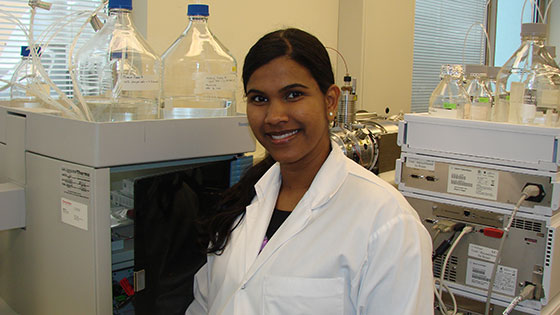This is the first installment of a three-part series highlighting the Laboratory Medicine Program's
critical role in providing quality patient care.

Dr. Vathany Kulasingam, Biochemist, Laboratory Medicine Program, is helping to improve
UHN's approach to Vitamin D testing. (Photo: UHN)
"As is your pathology, so goes your clinical practice." -- Dr. William Osler, 1890
UHN's Laboratory Medicine Program (LMP) ensures clinicians and patients have the testing information vital to patients' care. With thousands of tests, LMP evaluates which tests are being ordered and examines whether changes are needed to certain orders.
The laboratory has a "right test, right time, strategy" according to Brad Davis, Executive Director, Laboratory Medicine Program. Each laboratory test is evaluated to ensure it will deliver clear, actionable results to the physician in a way most meaningful to the patient's care.
A recent example of LMP's test utilization strategy involves the use of 25-OH Vitamin D testing.
The Ministry of Health and Long-Term Care has issued several recommendations around vitamin D testing. Routine vitamin D testing is not recommended for the general population and such a test should only be ordered for patients who meet specific clinical criteria.
According to LMP biochemist Dr. Vathany Kulasingam, UHN performed more than 6,000 vitamin D tests in 2010. She noticed significant increases of an additional 1,000 tests per year, reaching an estimated 9,000 orders for 2013. With only 7 per cent of the general population classified as severely deficient in vitamin D, the numbers did not match up.
"We need to be thinking critically about what tests we order for our patients," said Dr. Kulasingam.
Vitamin D is a common test that a patient is familiar with, but, at $35 per test, the LMP team connected with the clinicians to see when the test at UHN would be administered.
"An important feature of our test utilization strategy is having our biochemists work with their clinical colleagues in establishing the right approach for each test," said Dr. Sylvia Asa, Medical Director, Laboratory Medicine Program.
"We believe in evidence. We encourage our team to work with the clinicians to look at what tests are being ordered, ensuring we don't duplicate orders and making sure every test will deliver an actionable result. That is the principle of our test utilization strategy and the heart of patient-centred care," added Dr. Asa.
As part of the test utilization strategy, the guidelines for ordering the vitamin D test will be changed in EPR to include selecting the appropriate clinical context in which this test is being order, as outlined by the Ministry of Health.
"UHN, like all academic centres, has a different patient population than many other hospitals," said Dr. Eleftherios Diamandis, Chief, Department of Biochemistry. "We know that our patients have a different set of needs – but we have a responsibility to look at every test we do to assess whether or not we need that particular piece of the puzzle."
Vitamin D testing is most appropriate for clinical care with patients suffering from osteoporosis, osteopenia or fragility fractures, rickets, malabsorption syndromes, renal disease, on medications that affect vitamin D metabolism or the three month follow-up testing of patients with confirmed vitamin D deficiency/insufficiency.
With the establishment of several screening questions in EPR, LMP estimates there will be a 50 per cent decrease in the ordering of vitamin D testing, amounting to savings of over $100,000 annually. It also means that patients will not make more trips to the hospital and experience the discomfort of a blood draw.
"Cost saving is important, and reducing unnecessary pressure on our laboratory is important," said Dr. Asa. "But the most important part of our job is to deliver quality laboratory medicine. That's what our test utilization strategy supports and that's what we are achieving – better laboratory medicine for our patients."
